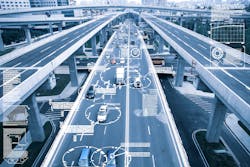Demystifying artificial intelligence in video security
Artificial intelligence is transforming video security, yet many misconceptions persist around what AI-driven solutions can and cannot (or should not) do.
Part of this stems from the complexity of modern machine learning, which seems like math magic to the average person. Another factor is the hype and sensationalized marketing claims that set unrealistic expectations. With some clarity of understanding, security professionals can evaluate how AI can enhance their operations, objectively separate facts from fiction, and dispel the mystique surrounding this powerful new set of technologies.
Video analytics have been around for years, but since around 2009, the feasibility of deep learning has led to successive waves of intelligent features. By training neural networks, basic analytics tasks like motion detection, object detection and tracking objects within scenes have become commonplace.
Cameras and video management technologies can now detect fine attributes of objects (for example, people and vehicles), to track objects across multiple cameras, and to detect and flag anomalies. In the research lab, techniques for the detection — and even prediction — of the relationships between objects, behaviors and interactions are being experimented with. This level of AI enables meaningful insights and proactive security capabilities.
AI is being incorporated into cameras and sensors, video management software (VMS) and video analytic add-ons. With the broader availability of AI-powered devices and software, industry adoption is accelerating.
Impact on the Video Security Industry
Video security systems are undergoing a transformation driven by the emergence of data-driven video technologies, smart edge devices and AI-enabled video analytics. These technologies are impacting the industry in three important ways:
- Superior video analytics: AI empowers security systems to extract better video insights. For example, through pose estimation — that is, an understanding of the articulation of people within a scene — analytics solutions can determine behaviors, such as whether people are engaged in hostile or benign interactions. Anomaly detection software can recognize unusual events that may signal safety hazards. AI is enabling security teams to gain much richer situational awareness from their video data.
- Enhanced operational efficiency: With the ability to search video data by specific objects, actions or anomalies, investigators and security teams can save a significant amount of time. Alarms can be filtered for only the most critical events needing human review. Together, this reduces human monitoring needs and makes security teams more efficient and informed when responding to a situation.
- New applications: AI is powering exciting new video use cases like predictive video analytics, which can detect behaviors that signal the likelihood of certain events before they occur. Predictive solutions analyze live and recorded video, with the possibility to include data beyond video, and learn the patterns associated with desired or undesired outcomes. Prescriptive analytics goes one step further and predicts interventions that may avoid undesired outcomes altogether. For example, if the system detects a car stalled in a traffic lane, it might predict how to divert traffic to prevent this turning into gridlock.
Having a “human in the loop” is an important part of these solutions. A predictive model may be used to send an alert to prompt human operators to review the video and decide if action is needed. The more data the system has to learn from and the more feedback it gets from operators, the smarter it gets at making predictions. Predictive analytics makes it easier for security personnel to monitor activity and respond quickly when necessary.
Actionable Automated Assistance
While many may think the role of video analytics is to make decisions for humans, the reality is the opposite. Analytics simply analyze the vast streams of data, looking for anomalies that may indicate an activity or situation that is out of the ordinary. Video analytic solutions are most effective when combined with other security technologies, bringing together video, audio and various complementary data for greater context and evaluation capabilities.
Today’s open platform, data-driven video systems can ingest, process, and present vast amounts of data. Video management software can connect video and audio devices, along with access-control systems, IoT devices and sensors for detecting everything from air quality to fires to types of noises, and video analytics such as people counting and point-of-sale.
With AI, the types of conditions detectable by video management software are nearly unlimited and can be custom designed to meet the specific needs of an organization. For example, in hospitals, using the latest-generation video management software allows various departments to monitor events in real-time and make informed, proactive decisions as they occur. These management platforms can also integrate with a facility's existing systems, such as access control, lighting, alarm, and intercom systems — creating a comprehensive, proactive approach to safety.
Future Innovations on the AI Horizon
The security industry is now experiencing an accelerated evolution in AI and machine learning. Systems are delving deep into extracting multilayered information from systems, bridging the gap between transactional, video and audio data.
This isn’t just about analyzing recorded data anymore — the industry is transitioning from reactive to proactive. Soon, video security will be reshaped by new AI capabilities, including:
- Scene understanding: AI will provide holistic contextual information to enable smarter video analytics by analyzing entire scenes captured in video data, rather than just detecting individual types of objects within them.
- Multimodal analysis: By combining data from multiple modalities (video, thermal video, depth sensors, LIDAR, audio, IoT sensors), multi-modal AI solutions can draw insightful conclusions, or make more accurate predictions, about people, vehicles, behaviors, and more.
- Synthetic data: This is information that's artificially generated rather than produced by real-world events. Synthetic data is valuable because it helps to reduce bias by building diversity into the training data that may not be found in the original, real data. Another benefit of synthetic data is to protect the privacy of individuals and avoid the consent issues that arise from using real consumer information without permission or compensation.
The Smart Road Ahead
AI will continue to shape the roadmap for the video security industry, but it’s not removing people from the solution, it’s moving people to the center of the solution. AI is now the tool at the periphery doing the watching and analyzing, not only identifying objects, but also making sense of what’s happening in scenes. At the center, people function as a “human in the loop” using their skills to verify analysis and make decisions on what to do. The path forward for technology developers and system integrators is pivoting sharply toward AI-enabled devices and solutions. Partnering with suppliers at the forefront of AI innovation will be essential.
As AI enhances video analytics, the human element remains vital. AI is only as smart as the data it learns from, and leveraging human oversight and expertise will maximize the value of AI solutions.

